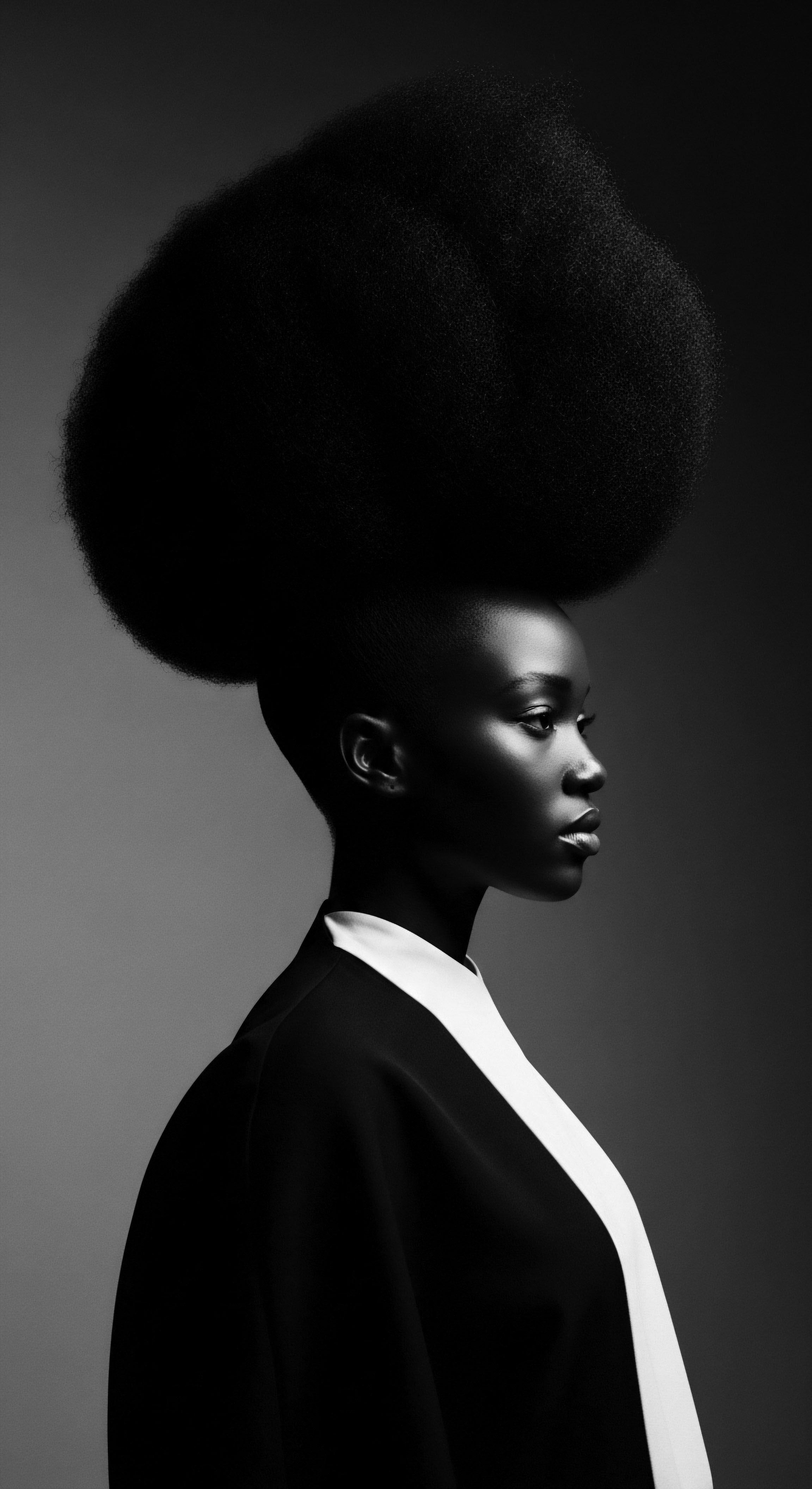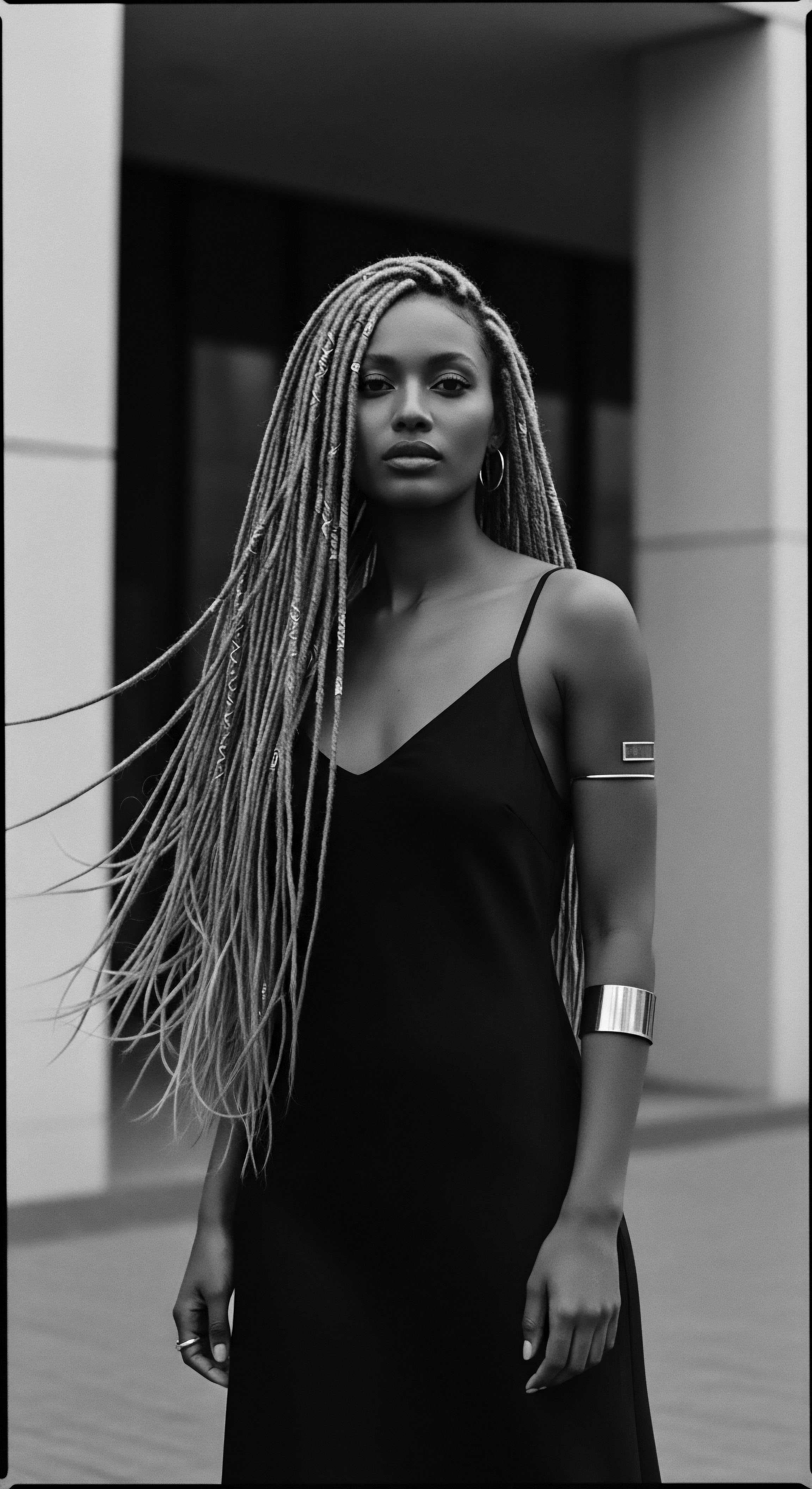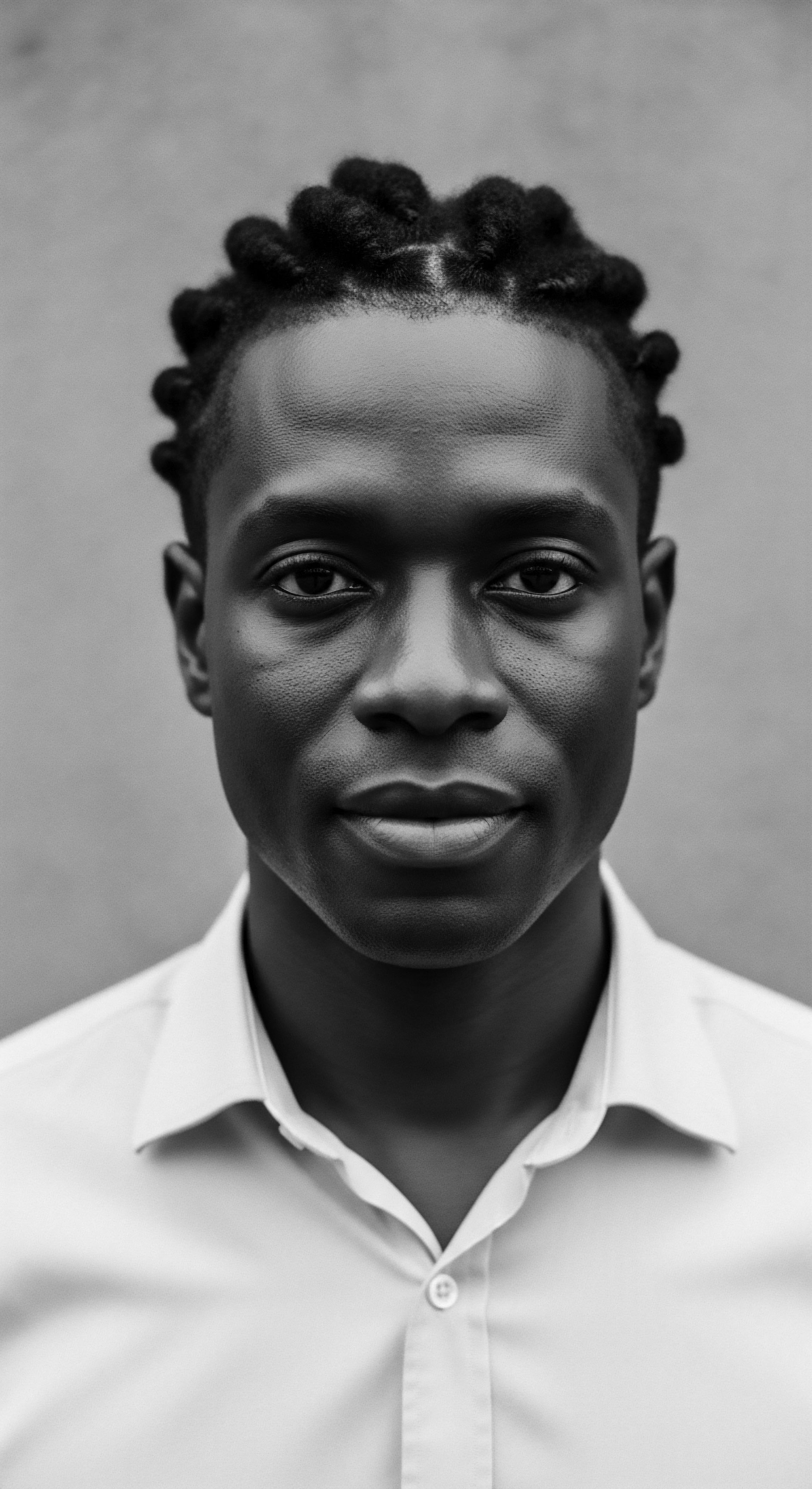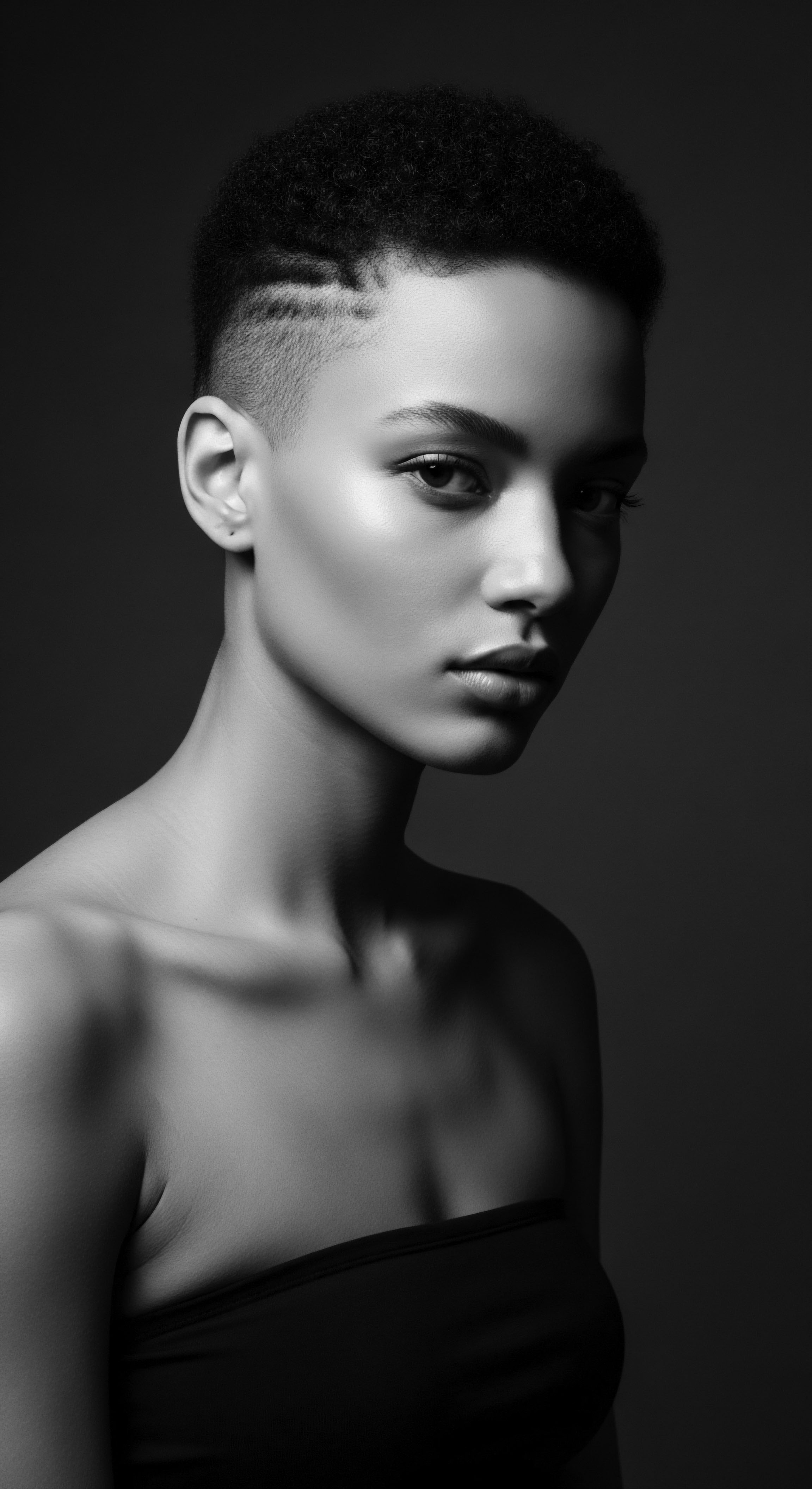
Roots
There are whispers carried on the wind, stories held within each coil, each strand, of textured hair. They speak of lands where sun drenched the earth, where ancestral hands gathered the bounty of nature, transforming it into elixirs of care. For those whose crowning glory spirals and coils with a unique grace, the bond with traditional ingredients extends far beyond simple application.
It is a dialogue with epochs, a communion with lineage, a recognition of what has always served. This enduring connection raises a fundamental query ❉ why do these age-old remedies remain so profoundly vital for textured hair today?

A Hair’s Ancient Blueprint
The very architecture of textured hair, from the tightest coil to the softest wave, possesses distinct qualities that set it apart. Its elliptical or flat cross-section, the unique distribution of disulfide bonds, and its inherent tendency toward dryness make it a marvel of biological engineering. This structure, a gift of deep time, means it responds differently to moisture, tension, and external elements.
Our forebears, through centuries of observation and practical wisdom, recognized these inherent characteristics. They did not possess electron microscopes or chemical analysis kits, yet their empirical understanding of hair’s needs — its thirst for moisture, its need for gentle handling, its capacity for intricate shaping — was remarkably precise.
Long before modern science codified its findings, communities across Africa developed sophisticated regimens. Their knowledge stemmed from direct interaction with the natural world. They observed which plants held moisture, which provided gentle cleansing, which offered protection from the sun’s harsh rays or drying winds.
The ingredients they chose were not arbitrary; they were selected for specific, perceived benefits that aligned with the hair’s unique biological requirements. This ancestral ethnobotanical wisdom, painstakingly gathered and passed from elder to apprentice, mother to child, laid the groundwork for what we now understand as specialized textured hair care.
The deep, ancient wisdom surrounding textured hair care is a historical archive written in plant knowledge and inherited practices.

The Lexicon of Enduring Care
To speak of traditional ingredients is to utter names that carry the weight of generations. Consider Shea Butter, extracted from the nuts of the karité tree, a staple across West Africa. Its emollient properties, rich in fatty acids and vitamins, made it a cornerstone for conditioning and sealing moisture.
Or perhaps African Black Soap, a gentle cleanser crafted from plantain skins, cocoa pods, and palm oil, known for its purifying yet non-stripping action on scalp and strands. These are but two examples within a vast pantheon of natural elements.
For millennia, these ingredients were not just commodities; they were integral to daily life, sacred rituals, and communal bonding. Their widespread use was not coincidental; it was a testament to their efficacy across diverse hair patterns and environmental conditions. The science now affirms what ancestors instinctively knew ❉ these botanical treasures offer lipids, antioxidants, and anti-inflammatory compounds that directly support scalp health and hair integrity.
The names themselves often echo their origins, tying directly to the lands and peoples who first recognized their value:
- Marula Oil ❉ Sourced from the Marula tree, native to Southern Africa, it is light yet deeply hydrating.
- Chebe Powder ❉ An herbal blend from Chad, traditionally used to fortify strands and maintain length.
- Rooibos Tea ❉ From South Africa, celebrated for its antioxidant properties and potential to support growth.
- Rhassoul Clay ❉ A mineral-rich clay from Morocco, valued for gentle cleansing and detoxification.

A Living Archive in Every Fiber
The very act of applying these ingredients becomes an engagement with history, a participation in an unbroken chain of generational knowledge. During the grim passage of the transatlantic slave trade, when deliberate attempts were made to strip enslaved Africans of their identity and cultural practices, the ingenuity and resilience of our foremothers shone through. In a truly profound historical example, documented accounts tell of enslaved African women braiding rice seeds into their hair before forced departure from their homelands. These seeds, hidden within intricate styles, served as a desperate, yet ultimately successful, act of resistance and survival, providing sustenance and allowing the cultivation of vital crops in new, unfamiliar lands (Carney, 2001b).
This powerful narrative illustrates the intrinsic link between hair, survival, and the profound, life-giving heritage of traditional practices and ingredients. Even in the absence of elaborate hair tonics, the hair itself became a vessel for sustaining life and culture.
This deep past colors our present. When a descendant of the diaspora reaches for shea butter, they are not simply choosing a product; they are tapping into a reservoir of ancestral wisdom. They are affirming a legacy of self-reliance and ingenious care that persisted through tremendous adversity.
Understanding the elemental biology of textured hair, then, is not merely an academic exercise. It helps us see how traditional ingredients were, and remain, biologically compatible with hair that craves specific molecular structures and restorative properties.
| Traditional Ingredient Shea Butter (Vitellaria paradoxa) |
| Ancestral Practice/Origin West African staple for skin and hair protection, moisture retention. |
| Contemporary Biological Benefit Rich in oleic and stearic acids, vitamins A, E, F; seals moisture, reduces breakage. |
| Traditional Ingredient African Black Soap (Alata Samina) |
| Ancestral Practice/Origin West African communities, used for cleansing hair and body, made from plant ash and oils. |
| Contemporary Biological Benefit Gentle surfactant action from plantain peel ash; clarifies scalp without harsh stripping. |
| Traditional Ingredient Chebe Powder (from Croton zambesicus seeds) |
| Ancestral Practice/Origin Chadian Bassara women for strengthening hair and length retention. |
| Contemporary Biological Benefit Saponins and alkaloids may fortify hair shaft, reduce friction, and prevent breakage. |
| Traditional Ingredient These ancestral choices reflect an intuitive grasp of the biological needs of textured hair, now validated by modern understanding. |
The inherent fragility of textured hair, prone to dryness and breakage due to its coiled structure, found its counterpoint in the protective and nourishing qualities of these plant-based ingredients. They offered slip for detangling, resilience against environmental damage, and vital nutrients for the scalp. The continuity of their use across generations and continents speaks volumes. It shows that certain truths about hair care, passed down as living traditions, hold a relevance that transcends time and shifting beauty ideals.

Ritual
The journey of textured hair care has always been steeped in ritual, a rhythmic dance of hands and natural elements. These practices, far from being mere routines, embody centuries of wisdom. Traditional ingredients are not simply applied; they are woven into sequences of care that speak to community, self-worth, and a profound connection to ancestral ways. The question then arises ❉ how did these traditional ingredients become so central to the styling and transformation heritage of textured hair?

The Artistry of Ancestral Styling
For centuries, the styling of textured hair was a sophisticated art form, deeply intertwined with social communication. Intricate braids, twists, and sculpted coiffures indicated a person’s age, marital status, tribal affiliation, and even spiritual beliefs. These styles, often requiring hours of communal effort, were not merely decorative; they were protective. The ingredients used within these processes were fundamental to their success and longevity.
Natural oils and butters provided the necessary slip for braiding, sealed moisture into the strands, and lent a lustrous sheen. Clays, sometimes mixed with plant extracts, were used to sculpt and define, offering hold without harshness.
The evolution of these styling practices, from pre-colonial African societies to the diasporic communities worldwide, is a testament to the adaptability and enduring spirit of Black and mixed-race people. Even when confronted with oppressive forces that sought to erase cultural identity, hair became a site of quiet rebellion and continuity. Protective styles, for example, were not only practical for managing and growing textured hair in diverse climates, but also served as a means to preserve distinct aesthetic traditions when other forms of cultural expression were suppressed. The ingredients chosen for these styles supported this dual purpose ❉ they were effective for hair health and accessible within community resource networks.
Styling textured hair with traditional ingredients is a living cultural act, echoing ancestral resilience and artistry.

What Role Did Community Play in Traditional Styling Heritage?
The communal aspect of hair care cannot be overstated. Hair braiding sessions were often intergenerational gatherings, where stories were shared, wisdom imparted, and bonds strengthened. In these spaces, the application of traditional oils like Palm Oil or concoctions of herbs became part of a shared experience. Grandmothers taught daughters, aunts guided nieces, and friends adorned one another.
This collective knowledge exchange ensured that the efficacy of certain ingredients for specific hair needs was continually validated and refined through lived experience. The communal setting also meant that the preparation and understanding of these natural remedies were deeply embedded in the social fabric, making them universally accessible within the community. There was an inherent trust in ingredients passed down through family lines, often harvested or prepared by trusted hands.
Consider the use of herbal rinses. In many traditional settings, leaves and barks like those from the Neem Tree or Aloe Vera plants were steeped to create conditioning rinses. These were applied after cleansing, not just for their detangling properties but for their perceived medicinal benefits to the scalp.
Modern science now recognizes the anti-inflammatory and antimicrobial properties of many such plants, affirming the ancestral wisdom. This blend of practical application, communal sharing, and an intuitive understanding of nature’s bounty cemented the role of traditional ingredients within the styling heritage of textured hair.
The continuity of these practices across generations demonstrates their deep utility:
- Pre-Colonial Africa ❉ Hair sculpting with natural clays and butters, intricate braiding patterns signifying social status.
- Diaspora during Slavery ❉ Covert use of animal fats and whatever plant extracts could be found to maintain hair health and cultural identity.
- Post-Emancipation & Civil Rights Era ❉ A re-affirmation of natural styles, bringing traditional ingredients back to the forefront as symbols of cultural pride.

Tools and Transformations with Nature’s Help
The tools of ancestral hair care were often simple, yet supremely effective, and often paired with traditional ingredients. Combing sticks carved from wood, gourds for mixing herbal solutions, and even fingers for detangling or applying balms. These tools, used in conjunction with the natural properties of ingredients like slippery elm or fenugreek, facilitated transformations from tangled coils to defined, lengthened styles.
The ingredients reduced friction, enhanced elasticity, and minimized breakage, enabling complex styling without causing damage. The wisdom of ‘low manipulation’ for textured hair, so widely discussed today, was an inherent aspect of these practices, where the gentleness of natural preparations allowed for styling that honored the hair’s delicate nature.
Even today, amidst an industry saturated with synthetic compounds, many still turn to these time-honored formulations. The familiarity, the generational memory, and the proven efficacy of these traditional ingredients provide a sense of grounding. They offer a tangible connection to a shared cultural story, where hair is not just fiber, but a living canvas upon which heritage is continually expressed. The continuity of their use, influencing modern styling practices, illustrates a profound legacy ❉ the very essence of hair’s styling possibilities for textured strands remains inextricably tied to the wisdom of nature’s offerings, passed through countless hands.

Relay
The journey of traditional ingredients for textured hair care is not a static one; it is a dynamic relay, a constant hand-off of wisdom across epochs and oceans. This continuity, far from being a mere historical curiosity, forms the very backbone of holistic care and problem-solving within the textured hair community today. Our focus now turns to a deeper consideration ❉ how does the enduring wisdom of traditional ingredients inform our understanding of holistic care and address contemporary hair challenges, all rooted in an inherited legacy?

Ancestral Wisdom and Modern Wellness Regimens
The rhythm of care in ancestral communities was inherently holistic. Hair health was not viewed in isolation, but as an extension of overall well-being. Diet, spiritual practices, communal harmony, and the use of natural remedies for the entire body all played a part. This integrated approach meant that ingredients used for hair often had broader health benefits, reflecting a deep understanding of the interconnectedness of systems.
For example, indigenous plant knowledge often combined topical application with internal consumption, signifying a comprehensive approach to vitality (Adu-Tutu et al. 2008). This understanding is a crucial aspect of the relay of wisdom.
In building personalized regimens today, many look back to these foundational principles. The contemporary desire for ‘clean beauty’ and ‘natural products’ is, for textured hair communities, a return to what always was. The preference for unrefined Cocoa Butter or Avocado Oil goes beyond trends; it stems from a lived experience that affirms their compatibility with hair prone to dryness. These natural lipids mimic the protective sebum our scalps produce, offering unparalleled lubrication and fortification to the hair shaft.
Modern science, through studies on fatty acid profiles and antioxidant activity, often validates the empirical benefits observed by generations of practitioners (Pereda et al. 2015). The ancestral path provided insights into topical nutrition long before the term existed in dermatological discourse.
The sustained efficacy of traditional ingredients is a testament to inherited knowledge, affirming what ancestors discerned through centuries of observation.

What Scientific Underpinnings Support Ancestral Practices?
The scientific community has begun to unravel the complex chemistry behind the enduring success of traditional ingredients. Take the example of African Threading, a method of stretching hair with thread, often pre-treated with oils or butters. This practice, used for centuries in West and Central Africa to protect hair and create styles, reduces the need for heat, which can compromise the integrity of coiled hair (Afolabi & Awofadeju, 2018). The application of traditional oils before threading minimizes friction and improves elasticity, directly addressing the hair’s susceptibility to breakage.
From a molecular standpoint, the lipids in shea butter or coconut oil penetrate the hair shaft, reducing protein loss and providing internal conditioning, thereby strengthening the hair against the stresses of manipulation. This scientific validation helps us understand the ‘why’ behind the ‘what’ of ancestral care.
Another compelling area involves the use of certain plant extracts for scalp health. Research into the ethnobotany of African plants identifies many species used traditionally for treating conditions like alopecia, dandruff, and infections (Gupte et al. 2011).
Plants from the Lamiaceae family, for instance, are known for their essential oil yield and anti-inflammatory properties, reflecting an ancestral application of what we now understand as phytochemical benefits. This deep historical knowledge of botanicals for therapeutic purposes signifies a relay of medicinal wisdom that extends beyond mere aesthetics, addressing fundamental issues of hair and scalp wellness.

The Nighttime Sanctuary and The Legacy of Care
The ritual of nighttime hair care, particularly the use of head coverings, possesses a profound historical and practical basis. While headwraps, historically, were often mandated expressions of control for enslaved women in the diaspora, they also served as a means of protection and a canvas for cultural expression (Byrd & Tharps, 2001). Today, the ubiquitous silk or satin bonnet, a descendent of these earlier wraps, shields textured hair from friction and moisture loss during sleep.
The materials chosen—smooth fabrics—minimize the snagging and absorption of natural oils, thereby preserving hair’s hydration and structural integrity. This modern practice is a direct relay of ancestral knowledge about protection and preservation, adapted for contemporary living.
The focus on protecting hair, especially overnight, speaks to a consistent concern for retaining moisture and preventing breakage – the two most significant challenges for textured hair. Traditional ingredients, such as a generous application of oil or butter, often preceded these protective coverings. This multi-layered approach to care, inherited from generations past, illustrates a profound foresight.
It safeguards the hair’s delicate balance, allowing it to regenerate and retain its strength, ready for the day’s demands. This continuity of protective wisdom reinforces the enduring value of traditional ingredients, not as quaint relics, but as dynamic participants in an unbroken chain of care.

Reflection
The question of why traditional ingredients continue their steadfast hold on textured hair care, when all is considered, brings us back to a soulful understanding. It is a dialogue between the Earth’s generous offerings and the deep-seated needs of a distinct hair type, a conversation spanning millennia. These ingredients are more than mere compounds; they are physical manifestations of inherited wisdom, of resilience, and of an enduring bond to ancestral ways. Every gentle application of shea butter, every careful rinse with a plant-derived infusion, is an affirmation of a heritage that refused to be severed.
It is a recognition of the ‘Soul of a Strand,’ a silent acknowledgment that our hair carries not only our genetic code but also the echoes of our past, the triumphs of our forebears, and the enduring beauty of traditions upheld. The vitality of these ingredients today is a testament to their undeniable efficacy, certainly, but also to their profound cultural resonance. They allow us to nourish our bodies while honoring our history, proving that the most profound forms of care often spring from the wellsprings of our own collective memory.

References
- Adu-Tutu, M. Yidana, J. A. Safo-Kantanka, O. Asase, A. Danso, F. & Boateng, A. (2008). Medicinal Plants and their Traditional Uses in Ghana. CSIR-Forestry Research Institute of Ghana.
- Afolabi, T. A. & Awofadeju, S. A. (2018). Traditional Hair Care Practices in Yorubaland, Nigeria. International Journal of Current Research.
- Byrd, A. D. & Tharps, L. L. (2001). Hair Story ❉ Untangling the Roots of Black Hair in America. St. Martin’s Press.
- Carney, J. A. (2001b). Black Rice ❉ The African Origins of Rice Cultivation in the Americas. Harvard University Press.
- Gupte, S. Sharma, M. & Singh, R. (2011). Ethnobotanical Survey of Plants Used in Hair Care from Central India. Journal of Pharmacognosy and Phytochemistry.
- Pereda, J. C. Gopaul, R. & Lodi, A. (2015). The Effect of Hair Treatments on the Physical Properties of Hair. International Journal of Cosmetic Science.
- Robbins, C. R. (2012). Chemical and Physical Behavior of Human Hair (5th ed.). Springer.
- Tressel, L. (2005). The Science of Black Hair ❉ A Comprehensive Guide to Textured Hair Care. CreateSpace Independent Publishing Platform.
